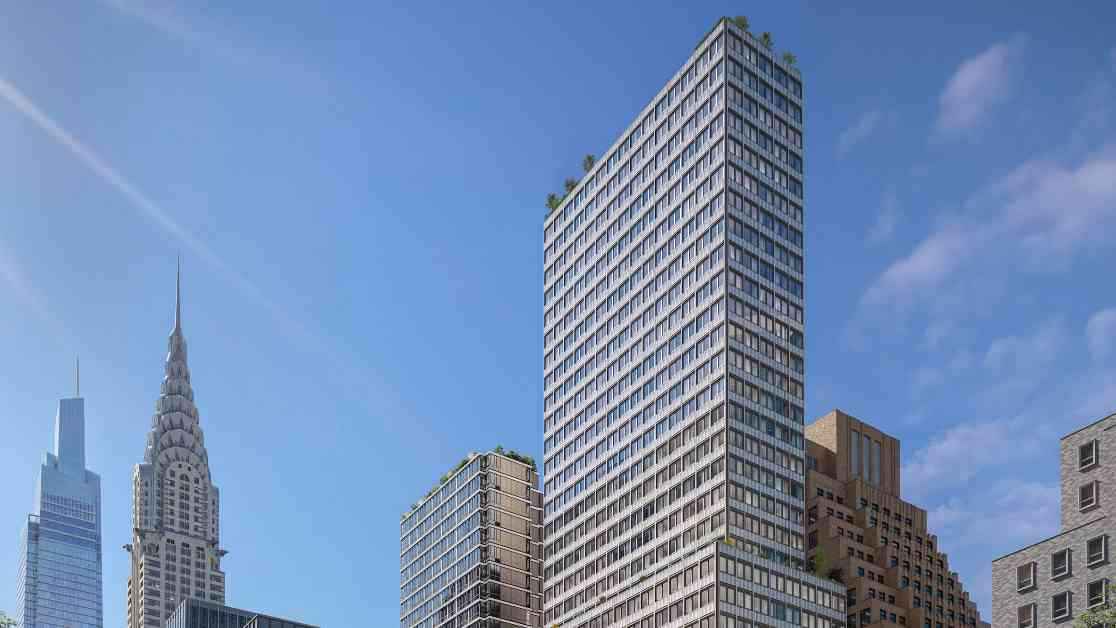Former Pfizer Headquarters in New York City Transformed into Vibrant Residential Development
In a bustling city like New York, where real estate is constantly evolving, the former Pfizer headquarters in Midtown Manhattan is set to undergo a remarkable transformation. American architecture studio Gensler has unveiled ambitious plans to convert the iconic office building into a stunning residential complex featuring two towers that will house a total of 1,600 apartments.
The project, situated at 219 and 229 East 42nd Street in East Midtown, involves repurposing a 33-storey tiered tower and an adjacent ten-storey tower into a dynamic mixed-use development. The design showcases a striking exterior with the taller tower prominently displayed at the front, while the smaller tower gracefully complements it from behind.
Gensler, a renowned design firm known for its innovative approach to urban development, envisions the converted space to offer a mix of approximately 1,600 apartment units, with 25 percent designated as affordable housing. Additionally, residents can look forward to a range of amenities, including a rooftop pool and fitness center, to enhance their living experience in the heart of Manhattan.
Robert Fuller, principal at Gensler, emphasized the significance of such conversions in revitalizing urban areas: “Conversions offer the promise of helping to transform more areas that were historically centralized business districts into vibrant, 24/7 neighborhoods.” He added, “New York City has a long history of repurposing outdated buildings to create new housing. We envision a future where office conversions in Midtown and the Financial District hold a similarly cherished place in the history of the city.”
Gensler will play a pivotal role in the project as the design architect, architect of record, and interior architect, ensuring that the development seamlessly blends functionality with aesthetic appeal. Collaborating with them are Metro Loft Development LLC and David Werner Real Estate Investments, the project owner and developers, respectively, who bring a wealth of experience to the table.
The former Pfizer headquarters, once a symbol of corporate prowess, will now undergo a metamorphosis into a vibrant residential community, marking a new chapter in the city’s architectural landscape. The buildings, which previously housed Pfizer’s New York headquarters, will see a new life breathed into them as they are reimagined for modern urban living.
As cities across the United States grapple with underused office spaces, the trend of converting commercial buildings into residential properties is gaining momentum. New York City and Chicago have both introduced initiatives to incentivize developers to repurpose downtown office buildings into affordable housing, reflecting a shift towards more sustainable and community-focused urban development practices.
With the project slated for completion in 2027, the former Pfizer headquarters will soon be reborn as a vibrant hub of residential activity, offering a glimpse into the future of urban living in one of the world’s most dynamic cities.
Expert Insights on Urban Development Trends
According to urban planning experts, the conversion of office buildings into residential spaces represents a growing trend in urban development, driven by the need to optimize existing infrastructure and create more inclusive communities. By repurposing underutilized commercial properties, cities can address housing shortages while fostering a sense of vitality and diversity in urban neighborhoods.
Legacy of Adaptive Reuse in New York City
New York City has a rich history of adaptive reuse, with many iconic buildings undergoing transformations to meet the changing needs of the city’s residents. From historic landmarks to modern skyscrapers, the city’s architectural landscape is a testament to the ingenuity and creativity of designers, developers, and urban planners who seek to preserve the past while embracing the future.
As the former Pfizer headquarters undergoes its remarkable transformation into a vibrant residential development, it serves as a reminder of the city’s enduring spirit of innovation and reinvention. With each new project, New York City continues to evolve, creating spaces that reflect the diverse and dynamic nature of urban life in the 21st century.












